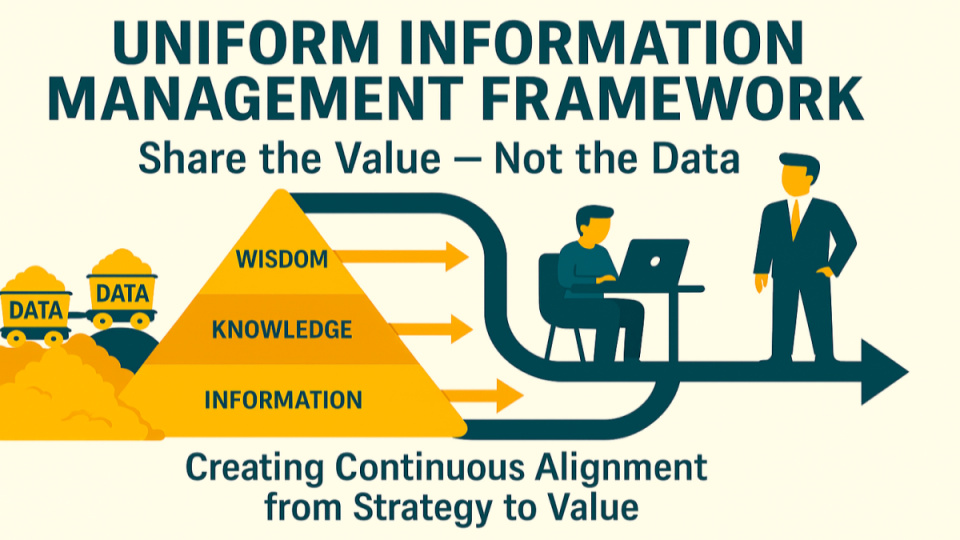
An integrative layer to bring meaning and clarity back to your data — without disrupting your structure
In the first three articles of this series, we uncovered a fundamental truth: Data doesn’t fail us because there’s too little of it. It fails because we don’t treat its meaning with the care it deserves.
We’ve seen how raw data, like gold ore, holds potential value. But without context, alignment, and purpose, it becomes just another pile of unused potential.
We’ve explored how strategy and operations often speak different languages — and how meaning gets lost in the space between them.
And we’ve highlighted the need for shared structure: a continuous two-way flow where wisdom doesn’t just emerge from data, but actively shapes how it’s collected, processed, and used.
Today, this article introduces the framework designed to make that possible.
What Is UIMF?
The Uniform Information Management Framework (UIMF) is not just another standard or compliance model. It’s the orchestration layer organizations have been missing.
Where other frameworks work well within their own verticals — like TOGAF for architecture, ITIL for service delivery, or ISO standards for various domains (e.g., ISO 9001 for quality, ISO 27001 for information security) — UIMF works across them.
It provides a common foundation that helps organizations:
- Align strategy with daily operations
- Protect and preserve meaning across silos
- Create clarity across roles, processes, and systems
UIMF doesn’t replace existing frameworks. It helps them work together.
What Makes UIMF Different?
UIMF is built on principles that make it both powerful and practical:
- Contextual: Meaning and value form the foundation. Every piece of information, every process, and every control clearly reflects the organizational purpose it serves.
- Value-focused: UIMF enables the translation of meaning into clear, value-based expectations, allowing others to act on information with confidence and alignment.
- Cyclic: UIMF employs a continuous PDCA (Plan–Do–Check–Act) cycle to ensure alignment and refinement of how meaning and value are managed throughout the organization.
- Integrative: UIMF acts as the connective layer between existing frameworks and standards (e.g., TOGAF, ISO, ITIL), ensuring coherence and alignment across all domains.
- Implementation-ready: UIMF adapts flexibly to your current structure and can be introduced gradually.
It acts as the shared map that connects intentions with actions, policy with process, and strategy with information.
What Does UIMF Look Like in Practice?
You don’t have to implement UIMF across the entire organization on day one. Start with one meaningful process — a compliance workflow, a reporting stream, or a customer-facing policy. Apply UIMF to clarify its purpose, define the related Information Processing Requirements (IPRs), and evaluate how information flows. This small start can trigger a broader shift toward clarity and alignment.
Imagine a system where:
- Strategic goals directly inform how information — and the data it consists of — should be interpreted, classified, and secured.
- Everybody understands how their work connects back to strategic goals — whether they’re designing, analyzing, securing, or supporting operations.
- Everyone knows exactly what needs to be protected, why it matters, and how it supports organizational goals.
- Compliance isn’t treated as a separate obligation — it becomes a natural reflection of business priorities.
UIMF makes this happen by creating a common logic between domains, roles, and systems. It embeds meaning where it matters most: inside the flow of work.
Meaning is what gives information its relevance and direction; value is what makes that relevance usable — especially for those not directly involved in defining it.
What that meaning looks like, however, differs depending on the domain, the role involved, and the systems in place. UIMF supports this by ensuring that value — once embedded by those who understand its meaning — becomes accessible and actionable to others. This makes it possible to steer both internal teams and third parties toward shared goals. In doing so, it helps operationalize strategy at every level — whether you’re making decisions, designing services, analyzing data, or handling customer questions. It provides a bridge between strategic intent and operational reality.
UIMF introduces the concept of Information Processing Requirements (IPRs): specific, context-driven definitions of what “correct handling” means for each piece of critical information. These include requirements for reliability, confidentiality, integrity, availability, accuracy, compliance, and more — derived directly from business goals. This is how meaning becomes operational: not by vague alignment, but by clearly defined expectations for how information should be treated.
And this doesn’t stop at the organization’s boundaries. UIMF also provides structure for working with third parties — enabling your external vendors, suppliers, and service providers to align with your strategy without needing access to all your internal information. It doesn’t share the data itself — it shares the value of that data, so third parties can build their processes and solutions around what truly matters to your organization.
In this way, UIMF becomes a mechanism to steer and verify third-party alignment with internal goals — not by enforcing controls, but by clarifying intent.
Where Other Frameworks Stop, UIMF Connects
The reason silos persist isn’t because frameworks are broken. It’s because they’re not connected.
TOGAF helps architects, ISO standards guide operational excellence and compliance in various domains, and NIST supports security professionals. But none of these standards explain how those efforts align — or how they relate to the goals of the business.
UIMF fills that gap.
It gives everyone a shared lens, a shared process, and a shared vocabulary — so information is always understood, protected, and refined according to its purpose.
It helps eliminate duplicated controls, reduces audit fatigue, and transforms fragmented checklists into a unified way of working across all frameworks — saving time, cost, and effort.
What’s Next?
In the next articles, we’ll explore how UIMF works in more detail:
- The PDCA-based refinement cycle
- The key roles and how they interact
- Practical examples across security, compliance, and strategy
We’ll also show how UIMF supports real-world demands like:
- NIS2 alignment
- Responsible AI governance
- Managing complexity in hybrid and multi-cloud environments
And perhaps just as importantly — how to get started without overhauling everything at once. Start with one process or one team. Map its critical information, define its IPRs, align the controls — and watch the conversation shift from compliance to coherence.
For now, remember this:
Strategy only becomes real when meaning flows through it. UIMF is the layer that makes that flow possible.

 English | EN
English | EN 